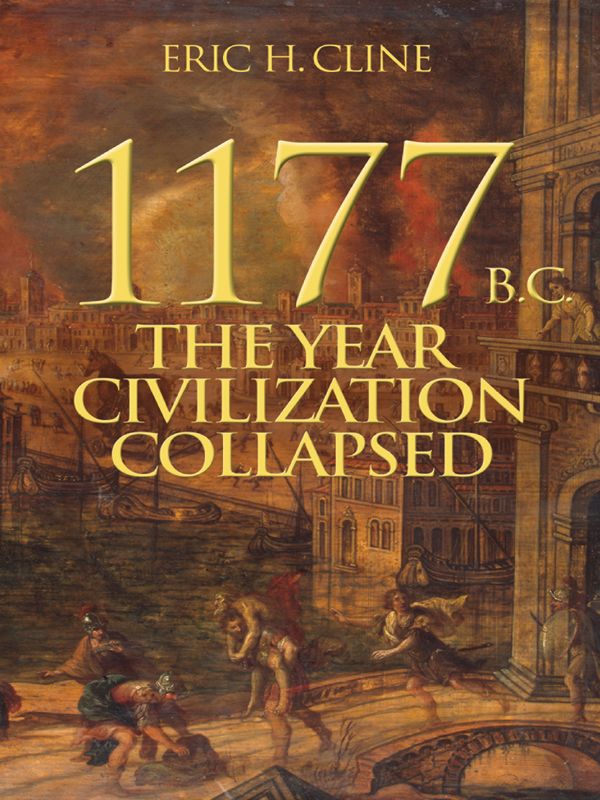1177 B.C.: The Year Civilization Collapsed (Turning Points in Ancient History)
Read 1177 B.C.: The Year Civilization Collapsed (Turning Points in Ancient History) Online
Authors: Eric H. Cline


1177
B.C.

TURNING POINTS IN ANCIENT HISTORY
Barry Strauss, Series Editor
Turning Points in Ancient History presents accessible books, by leading scholars, on crucial events and key moments in the ancient world. The series aims at fresh interpretations of both famous subjects and little-known ones that deserve more attention. The books provide a narrative synthesis that integrates literary and archaeological evidence.
1177
B.C.
THE YEAR CIVILIZATION COLLAPSED

E
RIC
H. C
LINE
PRINCETON UNIVERSITY PRESS
PRINCETON AND OXFORD
Copyright © 2014 by Eric H. Cline
Requests for permission to reproduce material from this work should be sent to Permissions, Princeton University Press
Published by Princeton University Press, 41 William Street, Princeton, New Jersey 08540
In the United Kingdom: Princeton University Press, 6 Oxford Street, Woodstock,
Oxfordshire OX20 1TW
Jacket art: Kerstiaen de Keuninck (Coninck).
Fire of Troy
. Oil on panel. 58.3 × 84.8 cm. Inv. no. GE-6780. Courtesy of The State Hermitage Museum, St. Petersburg. Photograph © The State Hermitage Museum / photo by Vladimir Terebenin, Leonard Kheifets, Yuri Molodkovets.
All Rights Reserved
Library of Congress Cataloging-in-Publication Data
Cline, Eric H.
1177 B.C. : the year civilization collapsed / Eric H. Cline.
pages cm. — (Turning points in ancient history)
Summary: “In 1177 B.C., marauding groups known only as the “Sea Peoples” invaded Egypt. The pharaoh’s army and navy managed to defeat them, but the victory so weakened Egypt that it soon slid into decline, as did most of the surrounding civilizations. After centuries of brilliance, the civilized world of the Bronze Age came to an abrupt and cataclysmic end. Kingdoms fell like dominoes over the course of just a few decades. No more Minoans or Mycenaeans. No more Trojans, Hittites, or Babylonians. The thriving economy and cultures of the late second millennium B.C., which had stretched from Greece to Egypt and Mesopotamia, suddenly ceased to exist, along with writing systems, technology, and monumental architecture. But the Sea Peoples alone could not have caused such widespread breakdown. How did it happen? In this major new account of the causes of this “First Dark Ages,” Eric Cline tells the gripping story of how the end was brought about by multiple interconnected failures, ranging from invasion and revolt to earthquakes, drought, and the cutting of international trade routes. Bringing to life the vibrant multicultural world of these great civilizations, he draws a sweeping panorama of the empires and globalized peoples of the Late Bronze Age and shows that it was their very interdependence that hastened their dramatic collapse and ushered in a dark age that lasted centuries. A compelling combination of narrative and the latest scholarship, 1177 B.C. sheds new light on the complex ties that gave rise to, and ultimately destroyed, the flourishing civilizations of the Late Bronze Age—and that set the stage for the emergence of classical Greece”—Provided by publisher.
Includes bibliographical references and index.
ISBN 978-0-691-14089-6 (hardback)
1. Bronze age—Mediterranean Region. 2. Mediterranean Region—Civilization. 3. Mediterranean Region—History—To 476. 4. Sea Peoples. I. Title.
GN778.25.C55 2014
930.1'56—dc23
2013032059
British Library Cataloging-in-Publication Data is available
This book has been composed in Minion Pro
Printed on acid-free paper. ∞
Printed in the United States of America
1 3 5 7 9 10 8 6 4 2
Dedicated to James D. Muhly, who has been debating these issues, and introducing them to his students, for nearly half a century


Frontispiece. Map of the Late Bronze Age civilizations in the Aegean and Eastern Mediterranean.
 CONTENTS
CONTENTS
PROLOGUE
The Collapse of Civilizations: 1177 BC 1
CHAPTER ONE
Act I. Of Arms and the Man: The Fifteenth Century BC 14
CHAPTER TWO
Act II. An (Aegean) Affair to Remember: The Fourteenth Century BC 43
CHAPTER THREE
Act III. Fighting for Gods and Country:
The Thirteenth Century BC 73
CHAPTER FOUR
Act IV. The End of an Era:
The Twelfth Century BC 102
CHAPTER FIVE
A “Perfect Storm” of Calamities? 139
Dramatis Personae
177
 ILLUSTRATIONS
ILLUSTRATIONS
F
IGURES
Frontispiece. Map of the Late Bronze Age civilizations in the Aegean and Eastern Mediterranean | |